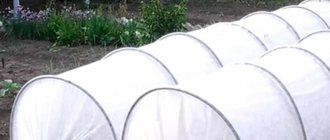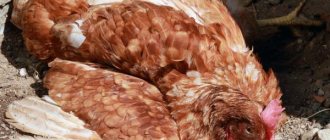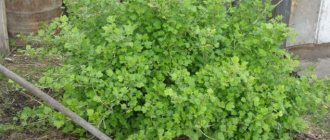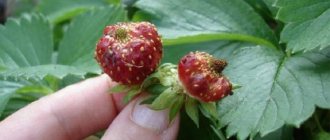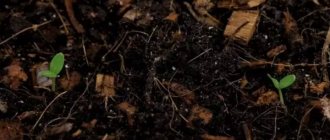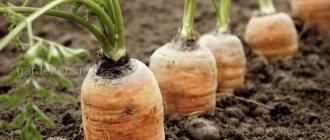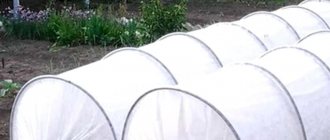Friends, do you want to have vitamins on your table all year round? I will tell you how to grow cucumbers at home, describe the reasons why cucumber greens do not grow on the balcony, and give important recommendations for caring for them to ensure full growth. By following a number of rules, beautiful and juicy cucumbers will grow right on the loggia.
This is what cucumbers grown on the balcony look like
Why don't cucumbers bloom on the balcony?
When I first grew cucumbers at home, flowering was rare. The reason for this is too dense planting and watering with cold water.
I corrected the situation the next time I landed, observing the following conditions:
- The seeds were laid out on pieces of cloth at a distance of 5 cm from each other and covered with gauze soaked in water. 2 days after the sprouts appeared, I planted the seeds in plastic jars with a small amount of soil to a depth of 2 cm and covered each jar with a plastic bag.
- For planting I used the following soil composition: garden soil, peat and sand in a ratio of 4:1:1. To disinfect from harmful microorganisms, the soil from the garden was first scalded with boiling water, dried a little, then mixed with peat and sand.
- A week later, when the stems and the first 2-3 leaves appeared, I planted the seedlings in a container measuring 3 x 0.5 m, using the same soil composition.
- When planting the seedlings, I made the distance between them 50 cm, and planted them about 5 cm deep, because the roots grow only in the upper layers of the soil.
- For active growth of green mass, after 3-5 days I applied nitrogen-containing fertilizer once, for which I dissolved 50 g of urea (urea) in 10 liters of clean water and watered the strong shoots at the rate of 0.5 liters per bush.
- For regular watering, I used water at a temperature of at least 25 °C. I watered the cucumbers once a day at the rate of 0.5 liters of water per plant bush, while leaving the soil around the base of the bush 1-2 cm dry to prevent the risk of root rotting.
- For abundant and full flowering, after 2 weeks I added another fertilizer based on phosphorus and potassium. I used wood ash, for which I poured five tablespoons of ash into 10 liters of boiled water and left for 24 hours. I strained and watered the cucumbers at the rate of 1 liter per bush (applied once a week).
A week later the cucumbers bloomed! How joyful it was to see the beautiful yellow flowers that decorated the green cucumber garden on the loggia.
Watch the following video, there is a lot of interesting information about growing cucumbers:
Friends, you will definitely succeed, just use seeds from a quality manufacturer. I used the seeds of the parthenocarpic variety F1 Window-Balcony, which I selected from this table:
| Variety | F1 Forward | F1 Faust | F1 Window-balcony | F1 Flagship |
| Recommended sowing time | Mid February | Mid February | Mid April | Mid March |
| Peculiarities | Tall with weak branching and increased shade tolerance. | Tall, with medium branching and increased shade tolerance. | Stress-resistant to temperature changes and drafts, shade-tolerant, early ripening. | Early ripening, shade-tolerant, with moderate branching. |
| Germination period | 1.5 months | 2 months | 1.5 months | 1.5 months |
Cucumbers can be planted at any time of the year, but the main thing is to maintain temperature and humidity (70 - 90%). The recommended air temperature during the day is 25-30 °C, and in the evening 15-20 °C.
For abundant flowering (2-3 weeks after planting the seedlings), use fertilizers based on phosphorus and potassium.
If you don’t want to grow hybrid varieties, find out how to grow regular varieties of cucumbers with seeds inside on your balcony.
Flowering of cucumbers and appearance of ovaries with proper care
Measures to improve the condition of plantings
If the crop is provided with all the necessary conditions for normal development, but the cucumbers still do not set, the plants are stimulated to produce fruit using systematic fertilizing. The latter not only promote flowering and ovary formation, but also extend the period of yield of a high-quality harvest. During the growing season, it is also important to prevent the development of cucumber diseases by carrying out preventive treatments.
For your information!
Natural products, thanks to the organic compounds in their composition, are safe for both humans and plants. Overdose is practically excluded, unlike the use of agrochemicals.
Adding organic matter
Mullein infusion is a common type of natural fertilizer that is well suited for feeding cucumbers. In case of necrotic manifestations, a working solution (aqueous) prepared in a ratio of 1: 10 is applied under the plants. The concentrate itself is used only after the start of fermentation. It is prepared from 1 kg of manure and 3 liters of warm water. Compost also shows good results in the form of intensive shoot growth and flower formation.
Mineral complexes
In order for the ovary to actively form and the fruits to reach full ripening, cucumbers need phosphorus and potassium. The first is responsible for metabolic processes in the plant and improves photosynthesis. It is applied throughout the growing season of the vegetable crop in the form of fertilizing irrigation - superphosphate granules are dissolved in warm water. As a result, the plantings will bloom more abundantly and produce a lot of ovary.
During the fruiting phase, in order to prevent the greens from falling off before they ripen, potassium is added to the fertilizing. It is advisable to use nitroammophoska, which is a complete mineral fertilizer. To increase yields, liquid microfertilizers can be added to irrigation water weekly according to the manufacturer’s instructions on the packaging.
How to help cucumbers start bearing fruit
In order for the cucumbers to bear fruit, during flowering and after the first ovaries appear, fertilize them once a week with a solution of nitrophoska (1 tbsp per 10 liters of water), and also spray the leaves with a mixture of complex fertilizer “Good owner” (diluted 150 g mixture per 10 liters of water). In summer, the temperature on my balcony is 30 °C, and at night it does not fall below 15 °C, which is completely normal for fruit growth.
Author's note
Natalia Papanova
Blog author
The temperature difference between day and night should not exceed 8 °C, since a sharp change in climate negatively affects the growth and development of fruits.
Cucumbers may not bear fruit due to diseases. Find out what diseases can occur in cucumbers growing on a loggia and how to deal with them.
Are you getting a harvest from your cucumbers on the balcony?
Not really
Problems when growing cucumbers on a windowsill
Owners of city apartments who do not have summer cottages or live in regions with long springs and short, cool summers are trying to grow vegetables on their balconies. In the latter case, the method of cultivating cucumbers on the windowsill allows you to harvest the greens much earlier than they even appear on sale (not taking into account products from greenhouses with year-round circulation).
Why do cucumbers bloom on the balcony but not set?
Last summer, when my loggia was not glazed, there were strong drafts for some time, which negatively affected the appearance of ovaries. Cucumbers do not like sudden temperature changes, strong winds and lack of lighting.
During the period of growth of green mass (shoots), before flowering, nitrogen-containing fertilizers cannot be used frequently, otherwise the plant will spend all its resources not on the development of ovaries, but on the growth of leaves.
Drying out or over-watering the soil for several days can also cause flowers to fall off.
Watch the following video and learn about the nuances of growing:
Mistakes of growing cucumbers in a winter greenhouse
Owners of winter greenhouses are incredibly lucky, because they will be able to enjoy delicious, healthy, crisp cucumbers grown with their own hands all year round, but they are not immune to mistakes.
The soil
One of the initial mistakes can be considered the incorrect composition and structure of the soil. Cucumbers on heavy, poor soils will not produce a harvest. Winter soil should be light, fertile, and easily allow air and moisture to pass through. The presence of leavening agents is welcome (perlite is the best winter option).
Seeds
A poor choice of seeds can ruin all your efforts. The modern assortment offers numerous hybrids that are more unpretentious for winter growth (inferior in taste to self-pollinating varieties): Emerald, Blik, Chipmunk, Romance. The hybrid "Cadet"o deserves special attention - it is shade-tolerant, cold-resistant, precocious, and disease-resistant.
Feeding
A must-have winter care item. Root and extra-root ones are used. It is not recommended to use potassium fertilizers containing chlorine; they inhibit the growth of the vine. Solutions used:
- urea - 1 g per liter of water, average consumption of 0.5 l - 1 m2;
- ammonium nitrate, superphosphate - 5 g per 1 l, consumption 0.5 - 1 m2;
- strained manure solution - 10 liter glass, consumption 2 liters - 1 m2.
Manure can be replaced with humic preparations at a concentration of 30 ml per bucket. Fertilize at least 5 times per season.
Care
All the nuances of care are not much different from summer growing. If the seedlings have stretched out, it is worth adding soil up to the cotyledon leaves and adjusting the lighting. LED lamps are recommended. Pay special attention to the prevention of diseases and pests. If the slightest signs are detected, remove all diseased parts and treat with appropriate fungicides.
How to care for cucumbers so that ovaries appear
Dear friends, in order to direct the plant towards the growth of ovaries, I reduced the number of leaves and shoots and pinched the stems 2 weeks after planting the seedlings. To do this, the main stem was cut from above at the height of the 12th leaf. The side shoots, starting from the second, were shortened to two or three leaves.
I created a comfortable growth for the plant, for which I installed a vertical peg 1 m high for the main stem, and for the rest I used twine connecting the peg and a vertically stretched rope above the plant 2 m high. On my loggia, cucumbers grew like small vines! Balcony hybrids branch well and grow in a suspended state while producing a lot of fruit.
Cucumbers growing along stretched ropes
The ovaries do not develop
Before purchasing seeds, be sure to find out how the plant is pollinated. For home cultivation, varieties that can be pollinated by hand rather than by insects are suitable. You can buy seeds from plants that are self-pollinating or not pollinating at all. You should not get carried away with fertilizers containing nitrogen, otherwise the ovaries will not appear. Every owner must pick up seedlings on time.
Why cucumbers set but do not increase in size
One of the reasons why cucumbers on the balcony do not develop is the excessive number of ovaries that appear on the shoots. In such cases, I leave the large ones (up to 30 pieces), and cut the small ovaries from the stems so that they do not take away some of the nutrients necessary for the growth of almost ripened fruits. The reason for stopping their growth can also be the lack of necessary feeding and too high a temperature (above 35 ° C).
Different varieties of cucumbers require an individual approach and conditions. Learn about the rules for pinching cucumbers on the balcony.
Reviews
Anna, 64 years old:
“I lived most of my life in the suburbs in a private house, I got used to serving vegetables that I grew myself in the garden. After I became a resident of a high-rise building, I couldn’t resist trying to get a harvest of cucumbers on the balcony. I chose the hybrid for protected soil, sowed the seeds as for seedlings, only in a large container, and took care of them constantly. The bush grew strong, and after 40 days I picked the first cucumbers. Their taste was simply excellent, compared to the greens that I bought in the store.”
Lyudmila, 36 years old:
“I have a dacha, but as an experiment I tried to get a harvest of balcony cucumbers. It only worked the second time. The first seedlings dried out at the seedling stage. The reason turned out to be the wrong variety and too shaded place.”
It’s not difficult to get a rich harvest of delicious greens on your balcony. The main thing when growing vegetables in such conditions is to select the appropriate variety, create an optimal microclimate and systematically care for the plantings.
Common diseases in seedlings and associated symptoms
If you properly care for the seedlings and do not allow the soil to become waterlogged, the plants will not get sick. If symptoms of disease appear, first of all, you need to get rid of yellowed leaves and diseased stems.
See also
How to quickly test cucumber seeds for germination in water, sawdust and paper roll
Read
Blackleg
When young seedlings develop cotyledon leaves, they may develop blackleg disease. This is a fungal disease. The roots of the plant turn yellow, the root collar becomes dark and thin, and the leaves wither. To combat, use a weak solution of potassium permanganate.
Mosaic
A viral disease that affects cucumber leaves. The virus can be in the soil or carried by insects. Many yellowish or brown spots and stains appear on the leaves. As a preventative measure, use a solution of potassium permanganate or Bordeaux mixture.
Signs of disease in adult bushes
During development, plants can become sick and “catch” a fungus in the soil. Cool, rainy weather can trigger the disease.
Copperhead or anthracnose
A fungal disease that occurs at high humidity. The disease develops on stems, leaves and fruits. Signs: brown spots that gradually grow and connect with each other. The disease causes leaves to fall off. For the fight, Bordeaux mixture, Fitosporin, Thiram, Immunocytophyte are used.
Downy mildew
A fungal disease also known as downy mildew. Signs: small yellow spots appear on the leaves, the ovaries turn yellow and fall off, the yield decreases. The disease develops with excess humidity and low temperatures (15 degrees Celsius). Fungicides are used for control: Hom, Ridomil, SILK, Fitosporin.
Sclerotinia (white rot)
A fungus that can affect cucumbers growing on the balcony. Signs: a white, cotton-like coating appears on the leaves and stems. It then transforms into slime. The top of the plant withers and the lower part of the stem begins to rot. The disease is provoked by low temperatures and high humidity. For prevention, the crop is fertilized with zinc sulfate, urea, and sprayed with copper sulfate.
Root rot
Watering too frequently with cold water can cause the roots to rot. Signs of root rot: brown tint of the roots and root collar, gradual withering of the leaves, starting from the lower ones. The ovaries dry out and fall off. For treatment, a solution of copper sulfate is used.
Gray rot
A fungal disease that appears on stems, leaves, and fruits. Signs: large grayish-brown spots, gradually increasing in size and leading to rotting. The disease occurs at high humidity and low temperatures. To process cucumbers, use the drug Trichodermin, Euparen multi.
Powdery mildew
A fungal disease that becomes active in damp, cool weather. Signs: white, rough, multiple spots on the leaves, then on the fruits and stems. For treatment use: Albit, Topaz, solution of wood ash or soda ash.
